
This series of videos focusing on calculus covers parameterizing a surface, surface integrals, stokes' theorem.
- Subject:
- Mathematics
- Material Type:
- Lecture
- Provider:
- Khan Academy
- Provider Set:
- Khan Academy
- Date Added:
- 07/12/2018

This series of videos focusing on calculus covers parameterizing a surface, surface integrals, stokes' theorem.

You can parameterize a line with a position vector valued function and understand what a differential means in that context already. This tutorial will take things further by parametrizing surfaces (2 parameters baby!) and have us thinking about partial differentials.
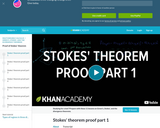
You know what Stokes' theorem is and how to apply it, but are craving for some real proof that it is true. Well, you've found the right tutorial!

Finding line integrals to be a bit boring? Well, this tutorial will add new dimension to your life by explore what surface integrals are and how we can calculate them.

This series of videos focusing on calculus covers calculating derivatives, power rule, product and quotient rules, chain rule, implicit differentiation, derivatives of common functions.
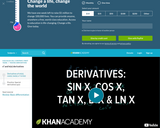
You can take the derivatives of f(x) and g(x), but what about f(g(x)) or g(f(x))? The chain rule gives us this ability. Because most complex and hairy functions can be thought of the composition of several simpler ones (ones that you can find derivatives of), you'll be able to take the derivative of almost any function after this tutorial. Just imagine.
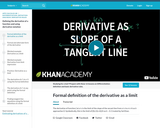
Discover what magic we can derive when we take a derivative, which is the slope of the tangent line at any point on a curve.

The topic that is now known as "calculus" was really called "the calculus of differentials" when first devised by Newton (and Leibniz) roughly four hundred years ago. To Newton, differentials were infinitely small "changes" in numbers that previous mathematics didn't know what to do with. Think this has no relevence to you? Well how would you figure out how fast something is going *right* at this moment (you'd have to figure out the very, very small change in distance over an infinitely small change in time)? This tutorial gives a gentle introduction to the world of Newton and Leibniz.
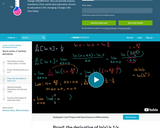
We told you about the derivatives of many functions, but you might want proof that what we told you is actually true. That's what this tutorial tries to do!

Calculus is designed for the typical two- or three-semester general calculus course, incorporating innovative features to enhance student learning. The book guides students through the core concepts of calculus and helps them understand how those concepts apply to their lives and the world around them. Due to the comprehensive nature of the material, we are offering the book in three volumes for flexibility and efficiency. Volume 1 covers functions, limits, derivatives, and integration

Calculus is designed for the typical two- or three-semester general calculus course, incorporating innovative features to enhance student learning. The book guides students through the core concepts of calculus and helps them understand how those concepts apply to their lives and the world around them. Due to the comprehensive nature of the material, we are offering the book in three volumes for flexibility and efficiency. Volume 2 covers integration, differential equations, sequences and series, and parametric equations and polar coordinates.

Calculus is designed for the typical two- or three-semester general calculus course, incorporating innovative features to enhance student learning. The book guides students through the core concepts of calculus and helps them understand how those concepts apply to their lives and the world around them. Due to the comprehensive nature of the material, we are offering the book in three volumes for flexibility and efficiency. Volume 3 covers parametric equations and polar coordinates, vectors, functions of several variables, multiple integration, and second-order differential equations.
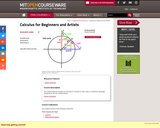
This online textbook provides an overview of Calculus in clear, easy to understand language designed for the non-mathematician.
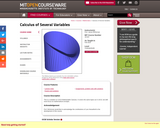
This is a variation on 18.02 Multivariable Calculus. It covers the same topics as in 18.02, but with more focus on mathematical concepts.
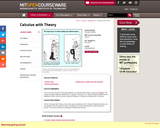
Calculus with Theory, covers the same material as 18.01 (Single Variable Calculus), but at a deeper and more rigorous level. It emphasizes careful reasoning and understanding of proofs. The course assumes knowledge of elementary calculus.

This is guidance on AI from California.

Students explore call and response songs through singing.

Calling on her two best known books, A Brilliant Solution: Inventing the US Constitution and Revolutionary Mothers: Women in the Struggle for America's Independence, Carol Berkin, Presidential Professor of American Colonial and Revolutionary History at Baruch College and the Graduate Center, City University of New York, briefly discusses some aspects of the American Revolution and the creation of the US Constitution.

This documentary tells the story of Lilly Ledbetter, whose fight for equal pay for equal work eventually involved all three branches of government. Her U.S. Supreme Court case, Ledbetter v. Goodyear Tire and Rubber Co., turned on the interpretation of the 180-day statute of limitations for filing a discrimination complaint under Title VII of the Civil Rights Act of 1964. After losing at the Supreme Court, Ledbetter urged Congress to start the 180-day clock for filing a complaint on the date an employee learned of the discrimination. The result was the Lilly Ledbetter Fair Pay Act of 2009.
Closed captions available in English and Spanish.

This lesson was designed for elementary school aged Special Needs students who often communicate using maladaptive behavior. Communicating our wants and needs can be done in a variety of ways. We can run around screaming, grabbing, or hitting people and receive a lot of negative attention, or we can choose a more effective way. We can communicate calmly. When we communicate calmly, we can give someone a clear message, much more quickly and using much less energy. To efficiently get our message across to someone, we need to do several things. We need to be calm, kindly get the person's attention, show the person what we want by saying the word, pointing at the object, or demonstrating the action. We will want the person to know we are giving our best, kindest effort. Therefore, we will use a gesture of kindness by saying (or signing) "please."